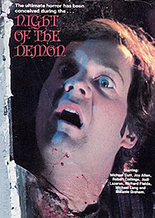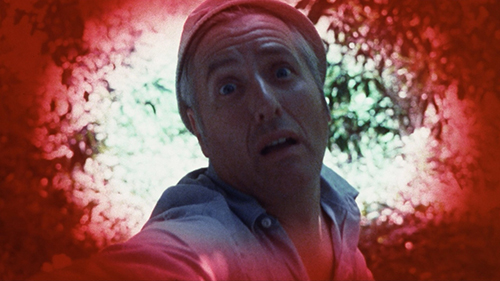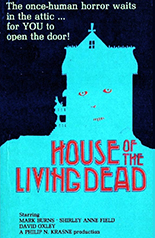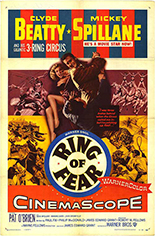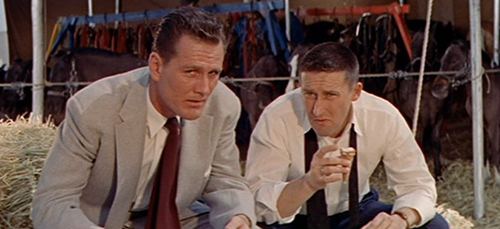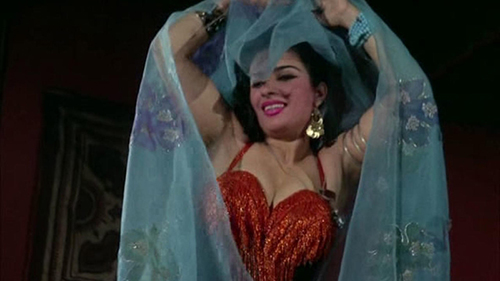
 Irascible, unkempt coot Snakey Bender (Les Tremayne, 1953’s The War of the Worlds) loves only one thing more than marching bands, and it’s certainly not baths or combs. It’s snakes, which he finds and sells for a living.
Irascible, unkempt coot Snakey Bender (Les Tremayne, 1953’s The War of the Worlds) loves only one thing more than marching bands, and it’s certainly not baths or combs. It’s snakes, which he finds and sells for a living.
In his tiny Texas town, Snakey may be known by everyone, but not necessarily beloved. In fact, he’s perpetually castigated by the cartoonish-looking pastor (Marvin Kaplan, Hollywood Vice Squad) for feeding “God’s creatures” (mice) to the snakes.
Every Wednesday night, Snakey’s schedule is packed. First, he and his farmer pal, Burt (Richard Kennedy, The Capture of Bigfoot), get drunk and dance to slabs of vinyl by John Philip Sousa … until Burt lands a hussy wife (Janet Wood, The Centerfold Girls).
Second, he brings his biggest and most phallic snake, Lucifer, to the home of the single school teacher (Bebe Kelly, If You Don’t Stop It … You’ll Go Blind!!!), who gets off sexually by wrapping the serpent around her muumuu-draped body … until she’s blackmailed by the sibling grocery store owners (C.B. Hustlers’ Bruce Kimball and Pee-wee’s Big Adventure’s Alice Nunn, Large Marge herself) into a threesome, lest word get out of her fetish and she loses her job.
With rural life suddenly against him at every turn, Snakey does what any viewer of Fangs waits impatiently for him to do: Take slithering, hissing, rattling revenge, letting his scaly pets serve as “judge, jury and executioner.”
 The only turn as director for Ted V. Mikels collaborator Art Names, Fangs isn’t the all-out reptile-attack picture as the Harry Novak production Rattlers or William Grefé’s Stanley. It’s more like a morality tale with a herpetology twist and dialogue that suggests Tennessee Williams ghostwriting Sordid Lives. Consider such dialogue as Snakey’s “Aw, horsefeathers!” and “Where in thunder you hidin’ the pork ’n’ beans?” — not to mention Nunn’s taunt of “What’s a-matter, Snakey? Don’t ya like my taffy?”
The only turn as director for Ted V. Mikels collaborator Art Names, Fangs isn’t the all-out reptile-attack picture as the Harry Novak production Rattlers or William Grefé’s Stanley. It’s more like a morality tale with a herpetology twist and dialogue that suggests Tennessee Williams ghostwriting Sordid Lives. Consider such dialogue as Snakey’s “Aw, horsefeathers!” and “Where in thunder you hidin’ the pork ’n’ beans?” — not to mention Nunn’s taunt of “What’s a-matter, Snakey? Don’t ya like my taffy?”
Take this with a drop of neither venom nor sarcasm: Tremayne is awesome in this. The part probably paid no better than the canned goods his character buys — on credit, mind you, because he’s dirt-poor — yet Tremayne doesn’t treat the drive-in material any differently. During the “band session” with Burt, he gives a monologue as devoted to his craft as Lawrence Olivier or Marlon Brando, never minding what he’s saying just amounts to an All Music Guide entry on Sousa.
Having grown up watching Tremayne mentoring TV’s Shazam! every Saturday morning, it’s not much of a stretch to imagine him getting drunk, kicking Billy Batson out of the RV and taking a hard right, only to end up deep in the dark, dark heart of Texas. Enjoy! —Rod Lott


